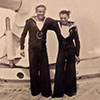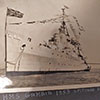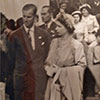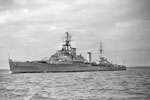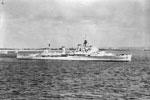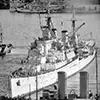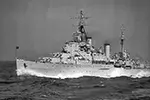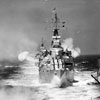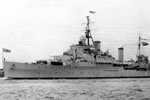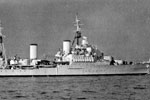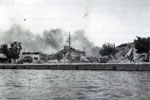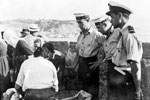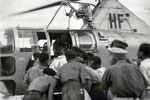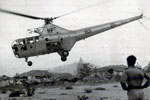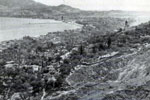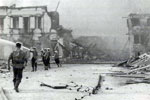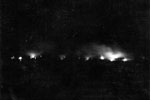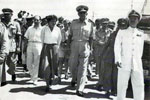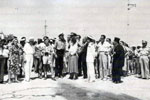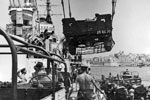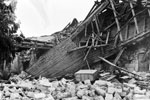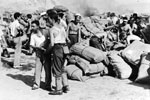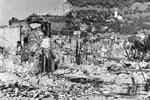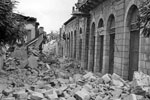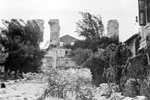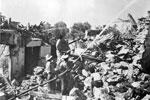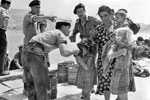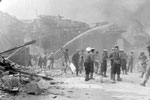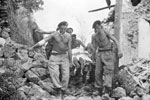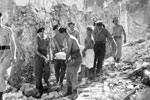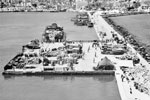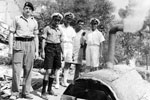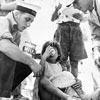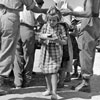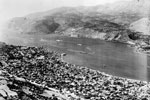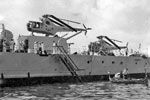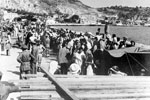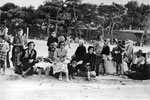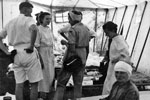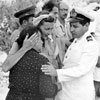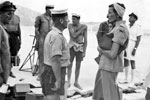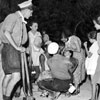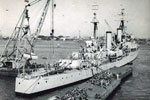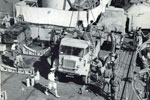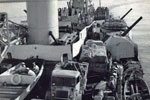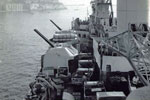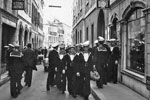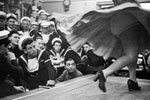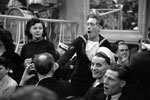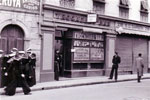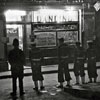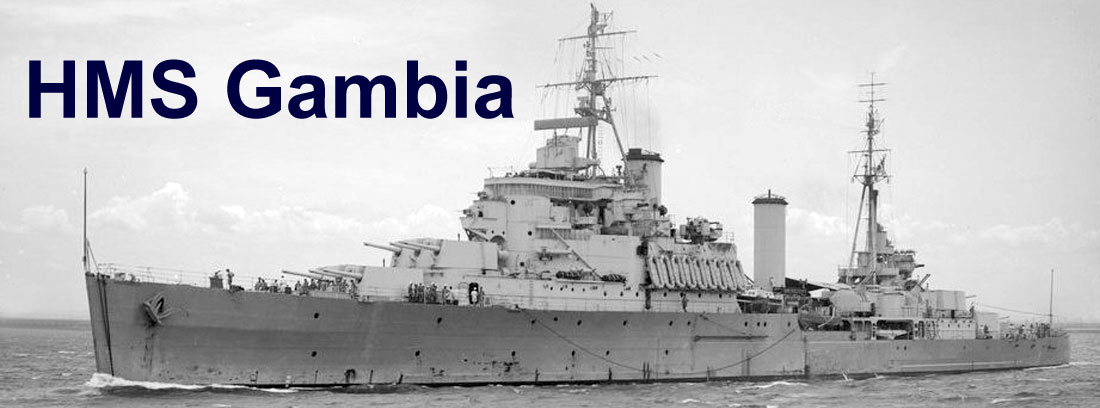
The 1952 to 1954 Commission
The 1952 to 1954 was an adventurous one for HMS Gambia. On June 15, 1953 she was present at the Coronation Fleet Review to celebrate the Coronation of Queen Elizabeth II at Spithead. In August 1953, she and her sister ship HMS Bermuda brought aid to the Greek island of Zakynthos when it was struck by a severe earthquake. In August 1954, HMS Gambia evacuated 40th Brigade of the Royal Marine Commando from the Canal Zone. There was also a Royal visit.
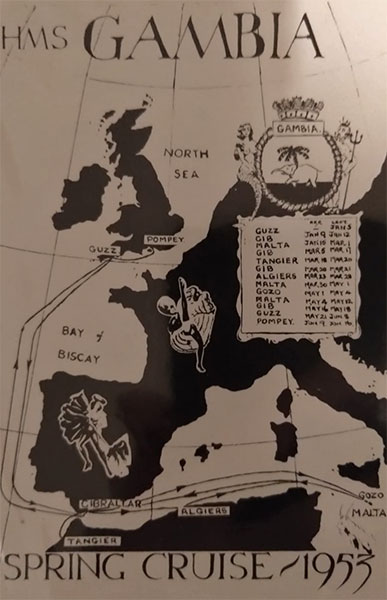
HMS Gambia's Spring 1953 Cruise
Image very kindly submitted by Michael Headon
Michael Headon is the son of Frank Graham Headon. Frank served in the Royal Navy from October 3, 1950 to August 1, 1960 and on HMS Gambia from March 12, 1953 to June 20, 1954.
Michael also very kindly sent the following photos of his father, Frank.
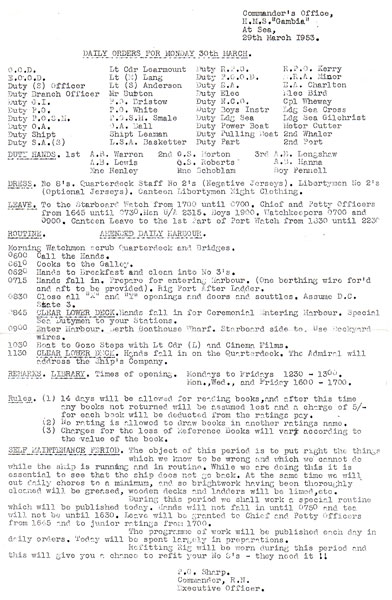
This page of orders dated March 29, 1953 for March 30, 1953, is from the material donated by Bill Hartland in August 2017. It reads:
O.O.D. - Lt. Cdr. Learmount
E.O.O.D. - Lt. (E) Lang
Duty (S) Officer - Lt. (S) Anderson
Duty Branch Officer - Mr. Burton
Duty G.I. - P.O. Bristow
Duty P.O. - P.O. White
Duty P.O.S.M. - P.O.S.M. Smale
Duty O.A. - O.A. Ball
Duty Shipt - Shipt Leaman
Duty S.A. (S) - L.S.A. Basketter
Duty R.P.O. - R.P.O. Kerry
Duty P.O.O.D. - E.R.A. Minor
Duty E.A. - Charlton
Duty Elec - Elec Bird
Duty N.C.O. - Cpl Wheway
Duty Boys Instr - Ldg Sea Cross
Duty Ldg Sea - Ldg Sea Gilchrist
Duty Power Boat - Motor Cutter
Duty Pulling Boat - 2nd Whaler
Duty Part - 2nd Part
Duty Hands
1st
A.B. Warren
A.B. Lewis
Mne Henley
2nd
O.S. Morton
O.S. Roberts
Mne Schoblam
3rd
A.B. Longshaw
A.B. Hanna
Boy Pennell
Dress: No 8's. Quarterdeck Staff No 2's (Negative Jerseys). Libertymen No 2's (Optional Jersyes). Canteen Libertymen Night Clothing.
Leave: To the Starboard Watch from 1700 until 0700. Chief and Petty Officers from 1645 until 0730. Men U/A 2315. Boys 1900. Watchkeepers 0700 and 0900. Canteen Leave to the 1st Part of Port Watch from 1830 until 2230.
Routine: Amended Daily Harbour
Morning Watchmen scrub Quarterdeck and Bridges.
0600: Call the Hands.
0610: Cooks to the Galley.
0620: Hands to Breakfast and clean into No 3's.
0715: Hands fall in. Prepare for entering Harbour. (One berthing wire for'd and aft to be provided). Rig Port After Ladder.
0830: Close all "X" and "Y" openings and doors and scuttles. Assume D.C. State 3.
0845: Clear Lower Deck. Hands fall in for Ceremonial Entering Harbour. Special Sea Dutymen to your Stations.
0900: Entering Harbour. Berth Boathouse Wharf. Starboard side to. Use Dockyard wires.
1030: Boat to Gozo Steps with Lt Cdr (L) and Cinema Films.
1130: Clear Lower Deck. Hands fall in on Quarterdeck. The Admiral will address the ship's Company.
Remarks. Library. Times of opening. Mondays to Fridays 1230 - 1300
Mon., Wed., and Friday 1600 - 1700.
Rules.
(1) 14 dys will be allowed for reading books, and after this time any books not returned will be assumed lost and a charge of 5/- for each book will be deducted from the ratings pay.
(2) No rating is allowed to draw books in another ratings name.
(3) Charges for the loss of Reference Books will vary according to the value of the book.
Self Maintenance Period. The object of this period is to put right the things which we know to be wrong and which we cannot do while the ship is running and in routine. While we are doing this it is essential that the ship does not go back. At the same time we will cur daily chores to a minimum, and so brightwork having been thoroughly cleaned will be greased, wooden decks and ladders will be limed, etc.
During this period we shall work a special routine which will be published today. Hands will not fall in until 0750 and tea will not be until 1630. Leave will be granted to Chief and Petty Officers from 1645 and to junior ratings from 1700.
The programme of work will be published each day in daily orders. today will be spent largely in preparation.
Refitting Rig will be worn during this process and this will give you a chance to refit your no 8's - they need it!!
P. G. Sharp,
Commander, R.N.
Executive Officer
Disaster Relief at Zante
During August 1953, there were 113 earthquakes recorded around the southern Greek Ionian islands between Kefalonia and Zakynthos, the latter being known to the British as Zante. Four of the earthquakes were major and the one on August 12 was massive, recorded as 7.2 on the Richter scale. This earthquake very caused severe damage to the islands of Kefalonia and Zakynthos and raised the whole island of Kefalonia by 2 feet. In Zakynthos, the capital of Zakynthos the island, only two buildings survived. All the buildings in the south of Kefalonia were destroyed.

The Commission Book for 1950 - 1954 records the start of HMS Gambia's role in the relief effort:
The Commission Book goes on to describe the work done by Gambia's crew on the island:At 0612 on August 11, the tour of duty at the Canal Zone came to an end as the old lady weighed both anchors and slipped from the jetty, bound for Malta. With not a care in the world she was halfway home, strolling along at her usual leisurely pace when at 1930 on August 12 a signal brought sudden drama. Disaster had struck the Ionian Islands: an earthquake had ravaged Zante and Cephalonia and help was urgently needed. As the ship heeled over in answer to her helm and the engineers strove for more speed the news was broadcast over the warning telephone, H.M.S. Gambia had altered course for Zante.
F R O M C - I N - C . M E D . T O G A M B I A - "Proceed at full speed to Argostoli in the Ionian Islands to arrive at first light - severe earthquakes have occurred." The epic of Zante was gradually unfolding its pages. The first paragraph was in print, the remainder had yet to be set on the presses in the chronicles of human suffering. The rest of the night and early morning found us hastily preparing emergency stores, provisions and equipment for relief work and although we were low on supplies after our duties in the Suez Canal, most of the items required were produced.
A further signal was received in the early hours of August 14 instructing us to proceed to the capital, Zakynthos, where the damage was believed to be the greatest. We sighted the island at 0700, the town itself hardly discernible through a thick haze of smoke which hung like a shroud over the still and silent town. A Greek landing craft was already anchored in the bay and the Captain was soon making contact with their personnel in an effort to discover the full amount of damage which the quake had wrought.
At 0800 the Royal Marine Battalion and two platoons of seamen and stokers were landed with demolition charges, shovels, and picks with the object of clearing a road through the town to enable casualties and supplies to be moved. The work of all parties was made extremely dangerous by the presence of hand grenades which were stored in practically every house and used by the local fishermen to stun fish; these were exploded continually under the heat of the blaze.
The town itself was found to be divided into three separate sections completely cut off from each other by masses of rubble and fallen masonry and the only possible means of reaching each section was by boat.
Zante had been on fire since the earthquake first struck and was still a blazing mass when we arrived.
From time to time frequent earth tremors still shook the ground and could even be felt on board ship as if depth charges were being exploded in the sea. Each tremor brought fresh destruction to this stricken area, piling debris upon debris until most of the narrow streets were buried to the height of ten feet with fallen bricks and shattered timber.
The only buildings to survive the devastation were the school, the bank, and one of the churches which had only recently been completed. These were taken over as casualty clearing stations and manned by a team of doctors and nurses who had been rushed across from the mainland. The more serious cases were dealt with on board the L.C.T. which had better facilities to deal with them.
The main task of the ship's firefighting squads was to prevent the fire from reaching and destroying the hospital, and as there were no appliances immediately available to fight the fire in the normal way, a fire ditch had to be cleared by means of blasting away the ruined buildings in the immediate vicinity.
By late afternoon the Royal Marines had succeeded in cutting and blasting a road through to the south of the town and casualties were hastily transported by our first-aid teams to the temporary hospital for treatment.
As night set in the sky was lit up by the flames which were still relentlessly eating their way through the town but the work went on unceasingly. Most of the ship's company had been ashore for the better part of the day and night, returning on board for a few hours' sleep before continuing the battle against nature's fury. The majority of the inhabitants had eaten no food for the past three days, neither had they been able to obtain any water and were in a pitiable condition. To ease the situation the bakery worked all hours turning out hundreds of loaves. Milk and every variety of tinned foods were sent ashore as well as water either in barricoes [small barrels], or when the situation became acute, by filling up the whalers and towing them ashore. The distribution of food, to ensure that every possible person was catered for, became as arduous a task as firefighting. Most of the ratings ashore gave up their bag meals rather than watch the expression on the faces of the island folk as they ate. Many a hardened salt was pressed into service as a nursemaid, tenderly holding a baby whilst trying to feed it from a tin of Ideal milk.
At 0800 on Friday, August 14, Earl Mountbatten, accompanied by Lady Mountbatten and staff officers, arrived in the bay in a R.A.F. Sunderland to view the damage and coordinate rescue work with the local Greek authorities. During all this time, Dakotas of the Greek Air Force were circling the town dropping food, medical supplies, and bundles of clothing to the survivors who were grouped around the outskirts of the town. Helicopters were landing on open spaces as well and taking the more seriously wounded back to the mainland.
By the time darkness fell a further road had been cut through. The town and the majority of the survivors had been formed into two large camps, one at each end of the town. This enabled us to carry out a rough census and also facilitated feeding arrangements. During the day two portable diesel pumps had been landed together with a considerable number of fire hoses which made the work of the fire parties much easier and soon most of the major fires were under control. On Saturday, August 15, an American landing craft and our sister ship, H.M.S. Bermuda arrived from Malta loaded up with jeeps, two helicopters, and a large amount of much-needed medical supplies and food. To us on the Gambia she was indeed a welcome sight as we had been coping with the aftermath of the disaster almost entirely on our own over the previous two days.
The remainder of the day was spent in turning the job over to Bermuda and landing the fresh equipment and stores. Amongst the new arrivals were many bell tents which were soon erected to form small villages to house the homeless population of Zante. Even more welcome were the large field kitchens so sorely needed to cope with the feeding arrangements.
Early on Sunday, August 16, we began to withdraw most of our equipment and rescue squads from the area and soon a long procession of begrimed and exhausted sailors was coming back on board. Most of them were asleep on their feet having preferred to carry on the rescue work throughout the night rather than take the well-earned rest which they so badly needed. Now others had taken up the task which we had started and our job for the present was completed.
At 1200 on Sunday, August 16, H.M.S. Gambia sailed for Malta, the following message being received from Mr. C. D. Bultzo, Member of Parliament for Zante;
"Having just come back from Zante and having worked side by side with the C.O. and Ship's Company of H.M.S. Gambia I would like to commend them for their gallantry and services rendered beyond the call of duty. We Greeks have a long-standing tradition with the Royal Navy and it lived up to every expectation in its infallible tradition of always being the first to help.
The high degree of discipline and training of H.M.S. Gambia's complement produced magnificent results felt all through the island of Zante. May I also convey to you as the Head of Her Britannic Majesty's Naval Mission here our heartfelt gratitude."
And as we sailed from Zante the following message received from the Greek destroyer anchored in the bay warmed our hearts "May God bless you and your gallant ship."
The British Royal Navy were the first to arrive to help with the relief effort, but ships from the United States, Swedish, French, Norwegian and Israeli navies all arrived.
Raj Bir Mohindra was an Indian sailor who served on HMS Gambia as a midshipman for her 1952 - 1954 Commission. Raj went on to have a very successful career in the Indian Navy and later as an education administrator.
Raj wrote this of the Zante operation for The Indian Express of March 3, 2023:
On August 12, an Admiralty Signal directed the Gambia to proceed to the Greek island of Cephalonia and carry out relief work in Argostoli, which had been hit by a severe earthquake. At midnight, we were suddenly diverted to Zante, an island in the Ionian Sea, off Greece’s west coast, devastated by an earthquake of a far greater magnitude. We reached Zante the following morning and anchored in the harbour. There was a dense cloud of smoke rising from the island, and fires everywhere.
The signal to proceed to the stricken island transformed the Gambia into a beehive of activity. All relief equipment, medical supplies, food, etc, were mustered and distributed between three rescue platoons. I was in the first platoon comprising seven Midshipmen (six from the Royal Navy and one, me, from the Indian Navy, all aged around 18), two Chief Petty Officers, 15 Seamen and medical staff, led by a young Royal Navy Lieutenant.
Our platoon landed ashore at about 8 am. Zante was a communist island. We were received by a commissar who requested the party to rush immediately to a shattered building about two furlongs away where voices had been heard. On the way, we came across ghastly scenes. Men and women wailed over the dead bodies of their kin. Severely wounded children wept incessantly with no medical aid in sight. I cannot find words to explain the nightmarish sights and sounds. Once we reached the building, we searched for two or three hours, but could only retrieve five dead bodies. All day we were approached by more people pleading with us to rush to nearby buildings where many others were buried under the earthquake debris.
At the end of the day in Zante, while waiting for a boat to take us back to the ship, the commissar returned and said that people had heard cries in the debris of a building behind a church. We rushed to the scene. We were able to retrieve one dead body of a woman. But much to our surprise, a young lad of around 16 crawled out behind her. He refused to be lifted and said he was in perfect order. He explained that a dead body had obstructed his way out from under the debris. He was quite cheerful and embraced me.
After this rescue operation, to my surprise, a lady came running towards me, hugged me tight and planted a huge kiss on my lips! She was the mother of the young lad we had rescued from the building behind the church.
In September 2017, 84 year-old Alan Mount emailed that:
As a Marine Commando (45) I didn't actually serve on Gambia but was travelling on her from Suez to Malta on completion of my military service. This was in August 1953, when she was directed to make max speed to Zante the Greek Island that had experienced a devastating earthquake. This has become part of Gambia's history, I was on the first ships boat sent ashore when we arrived. This was far from being a pleasure trip or pleasant experience.
When on Gambia I met a school friend Derek Funnel who was serving on her at the time (just one of life's little coincidences).
Day One
Arriving in the bay and seeing Zante covered in flame and smoke should have forewarned us of things to come.
A most unpleasant scene unfolded when we got ashore. I have not been to Zante since that day over 64 years ago, but the memory of what I was to witness that day is as clear now as it was then.
A road runs right round the bay and another road ran inland, it was a job to navigate or identify the road running inland as the buildings were all burning and destroyed and that had to be blasted through.
Coupled with this we would hear the explosions of grenades exploding deep within the burning buildings. And then a massive aftershock sent us running for the openness of the bay.
I must now retrace my steps to when we first arrived on the Island.
As we left the jetty there was a couple of large corrugated tins in the road and when I lifted them up there were two badly burned bodies, so badly burned were they that it wasn't possible to identify if they were male or female. All you could say that it was an adult and a half grown child.
Some distance along the bay road a child was born and mother and child were place on a car trailer on a bed of tree branches and driven away. Some 60 years later when contacted by Roz Mills I told her of this and ask if she could find if the baby survived and she didn't bother to find out.
You would think with her contacts in the council it would be easy to find out about a baby born in the road the day after the biggest earthquake in the islands history would be easily traceable.
he rest of day one was searching in collapsed buildings for survivors, which was hazardous work.
Day Two
Having had the briefest of sleeps on board Gambia it was back to the island for more of the same as the previous day, we felt very guilty about going back on board to kip but my memory is one of tremendous fatigue. The only difference on day two, was when we landed on the jetty there was a group of American military on there.with the required iced drink machines etc.
They were there in the morning when we arrived and still there when we returned later that night. Their day must have been a busy one, telling the adoring press what a great job they were doing.
I can honestly say hand on heart I never saw any other nationality involved in the work we were doing apart from the sailors and Marines from Gambia and Bermuda for the three days we were on the Island.
One nice recollection was how quick the Gambia's small shop ran out of sweets and chocolate bars, as all the guys were buying them to take ashore to give to the kid,. and where the official report says that Lord Mountbatten arrived to coordinate the rescue effort, I think this demeans the ability of the two Captains who organised the whole thing and this was without doubt a Royal Navy operation from start to finish.
My opinion is that Lord Mountbatten and his wife were there for a photo opportunity as always but anyhow he and his good lady must have arrived after we left as I never saw them but then as a lowly Marine he wouldn't have looked me up as our ranks were somewhat different.
Day Three
Day three started as did the previous two days with being out ashore early in the morning by ships boat to pic up where we left off the day before.
I'm not sure exactly when Bermuda arrived, but a lot of tents mysteriously appeared and we spent the rest of our time creating a tented village for the locals.
Whilst doing this King Constantine* and his wife the queen arrived and shook our hands and thanked us personally. Although this was nice, the real gratitude came from the islanders themselves, who having lost everything, went into the fields and cut melons to bring to us as the work we was doing was very hot.
* I believe that Alan was mistaken here. The king of Greece at the time was Paul and his wife was Queen Frederica.
I commend the men of HMS Gambia of which my mate and I stand along side although not listed as ship's crew are both proud to have been part of the work done by all of them.
I am happy to have had the chance to be associated with such a great ship.
Relief
Following the arrival of Bermuda and with Gambia's supplies virtually exhausted, it was necessary for her to hand responsibility to her sister ship and continue her trip to Malta.
I am not sure what time we left the island all I remember was the feeling of fatigue and tiredness we were all feeling , but to a man fatigue or not, all would have volunteered to have stayed as long as necessary to have finished the job.
Not a man there wanted thanks or thought they were just following orders, they worked long arduous and often dangerous hours willingly to assist their fellow man.
Return to the UK
Myself and Albie said goodbye to Gambia when we arrived in Malta and were put into an army transit camp, ready to fly home and demob. Arriving three days later than expected we got our heads down and went fast asleep, at just after nine the following morning, the door burst open and an army sergeant major was balling and shouting, and calling us lazy bastards, and as it turned out we had not read the notice board which we should have done, and had been down for cookhouse duties for the past few days and our trip to Zante had got in the way.
He ordered us outside in ten minutes and marched us before the CO an army Major. All he would say was that as we were flying home the following day he had no time to punish us both would send a report to the CO of Stonehouse Barracks in Plymouth where we were heading. We left Malta on an Elizabethan aircraft fly home. The plane developed engine problems on the way home and was diverted to Nice and we were put into the four star D'Albion in Nice for two days. What a contrast to the barracks in Malta.
On arrival in Plymouth we were placed under arrest and taken before the CO who said he took a dim view of two Marines giving the army cause to criticize the regiment. He said he had the choice of extending our service by 6 weeks, but as I told him I had a job to go too he relented and said that our remaining military service would be under punishment was 10 days and as we were one weeks leave prior to completion of service in meant our final days stay in Stonehouse would be under punishment.
I was told I must work in adjutants garden and must report to his wife in the officers' quarters at 8,30 the following morning. Knowing the Adj. was a miserable git of about 35 years old I expected the worst. But how wrong could I be. She was beautiful about 30ish and it was love at first sight, sadly it was from my part only and here I was a 21 year old Marine with hormones in overdrive, confronted with this lovely woman who treated me decently and kept an ever supply of tea and cakes going all day. It was a case of if this is punishment long may it last.
After a week's leave I was finally free of military rule and a week after leaving I started a career in the paper industry that was to span almost 50 years I must add nothing inappropriate ever happened between myself and the officer's wife mentioned, not that I wished it had done. This part of my life had its highs and lows and I'm sure you will understand if I say I want closure on it. After all life isn't fair is it
In October 2017, Alan sent me this amusing story:
It was customary at the time for Royal Marines travelling to far away places, to hitch a ride on any Royal Naval vessel going their way, and that was the reason my mate Albie Stringfellow and I were on Gambia, having completed our tour of duty with 45 commando we were travelling to Malta to fly home for demob.
As The Royal Navy don't do pleasure cruises. We were required to report to Gambia's Captain to be assigned duties. My job was to remind me why I as a Royal Marine was unsuited to sea service (seasickness)
Gambia had on board an old three badger who had been a naughty boy and was in the cells and as they are able to unhook the chain from inside the cell for safety reasons while at sea. My duty was to stand guard outside the cell to prevent any escape. Where he could escape to I never quite understood, but our was not to reason why.
Anyone knowing the type of ships Gambia was, will know two cells that are deep below decks in the bows of the ship and to be down there in rough weather when you are prone to seasickness is pure purgatory. It's like being continually lifted to the height a two story house and dropped, boy was I sick, so sick in fact, while I had my head in a bucket being sick, the prisoner let himself out of the cell and went walkabouts on deck came back checked that I was OK, locked himself back in the cell, and nobody was the wiser.
The whole episode was pure "carry on" and the fact he did all this without being spotted prevented me being put in the cell next to him. I bet he had many a laugh at my expense later It took a few hours for Gambia to raise a head of steam to proceed to Zante and being relieved of guard duty I was able to go up on deck. Once Gambia got up to speed and charged straight through the waves instead of following them up and down, my sickness completely disappeared and at speed it was difficult to stand out on deck.
In November 2017, Alan the following:
Royal Marines are all administered by the admiralty and only sea service Marines get a rum ration. at the time of my service I was paid 3 pence a day in lieu of daily rum. Talk about coincidence, when I was first posted to Suez we were based in a large camp shared by the Green Howards, the RAF regiment and the Army Ordnance Corp. My first night in the joint NAAFI was a surprise when I joined the queue behind an army chap who when he turned round it was an old school friend called Peter Black. We shared a beer or five that evening.
Unknown to Alan, his daughter Alison Anderson emailed me shortly after Alan started his emails. Alan felt that he and the other men of 45 Commando as well as some of the men of HMS Gambia did not get the recognition they deserved. It appears that on the 50th anniversary of the earthquake, members of the HMS Gambia Association were not informed of the invitation to revisit Zante and take part in the memorial activities. On the 60th anniversary, Alan was contacted by a reporter from Zante and plans were made for him to visit the island, but then Alan did not hear anything else from the reporter.
Alison and I had an idea and in October 2017 I emailed the government of Zante. On November 1, 2017 I received this email from the mayor, Pavlos Kolokotsas:
ΠΑΥΛΟΣ ΚΟΛΟΚΟΤΣΑΣ
Dear Mr Thomas,
Your e-mail took me by surprise. I was really touched to know that some members of the crew are still alive. The Zakynthian people and I personally feel obliged to those people you came for our grandparents and parents rescue.
I would like to express my gratitude to those people who helped us under such difficult circumstances. The words are not enough to tell them thank you. They are heroes to us and as heroes should be honored. Thus, I would like to invite them to Zakynthos on the following August when our Municipality will organize events for the anniversary of the earthquake and meet them and thank them. Mr. Thomas, do you think this would be possible? I know that August is 10 months ahead, but if we manage it would be the least we can do for them.
Mr. Thomas, please give them my and all Zakynthians warmest regards. Tell them that they are our heroes and we would soon like to see them in Zakynthos.
My warmest regards,
Pavlos Kolokotsas - Mayor of Zakynthos
Παύλος Κολοκοτσάς - Pavlos Kolokotsas
Δήμαρχος Ζακύνθου Mayor of Zakynthos Municipality
The surviving men are getting on a bit now, Alan is 84 (in 2017), and some of them are not in the best of health. But the work they did was and is still appreciated.
In November 2017, I got an email from Hank Herbowy. He wrote:
As a young Marine I remember it well. We were with the second battalion, Sixth Marines (Reinf) at Malta performing a NELM [Naval Forces, Eastern Atlantic and Mediterranean] Amphibious Operation when the order came through to proceed to Greece to aid the victims of the earthquake disaster, we sailed full speed for the Ionian Islands in the early hours of August 15, 1953 to the island of Zante. The village in complete destruction.
In August 1953, while on patrol with the 6th Fleet in the Mediterranean Sea with a reinforced Marine Battalion on board the USS Rockbridge and the USS Monrovia. The 6th Marines where ordered to sail to the Greek Island of Zante for a humanitarian rescue mission. The Island had experienced a severe earthquake. When Marines and Navy personal landed they found widespread destruction and loss of life. After administrating to the dead, injured and hungry the marines assisted in restoring power, repairing water mains,instituting sanitation measures, erecting temporary shelters and clearing roads. Only three building that I know of that remained standing, One bank and two churches. All other building on the Island was destroyed by the quake. Also involved with the rescue operations where the British Royal Marines and Naval Personal from the HMS Gambia.
Not many are left to remember this Earthquake as we are in our 80s and most are no longer with us.
Former Marine Sgt. Hank Herbowy
Hank also sent the clipping below:

Second Division Marines pick their way through rubble seeking victims on shattered island of Zante. Men interrupted war games with 6th Fleet to aid in rescue operation on Greek island
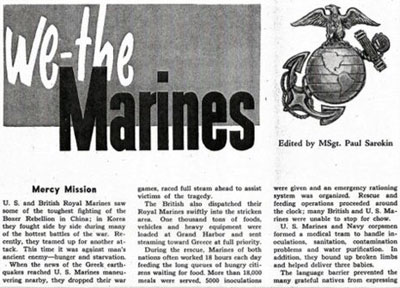
Mercy Mission
U.S. and British Royal Marines saw some of the toughest fighting of the Boxer Rebellion in China; in Korea they fought side by side during many of the hottest battles of the war. Recently, they teamed up for another attack. This time it was against man's ancient enemy - hunger and starvation.
When news of the Greek earthquake reached U.S. Marines maneuvering nearby, they dropped their war games, raced full steam ahead to assist victims of the tragedy.
The British also dispatched their Royal Marines swiftly into the stricken area. One thousand tons of food, vehicles and heavy equipment were loaded at Grand Harbor and sent streaming towards Greece at full priority. During the rescue, Marines of both nations often worked 18 hours each day feeding long queues of hungry citizens waiting for food. More than 18,000 meals were served, 5,000 inoculations were given and an emergency rationing system was organized. Rescue and feeding operations proceeded around the clock; many British and U.S. Marines were unable to stop for chow.
U.S. Marines and Navy corpsmen formed a medical team to handle inoculations, sanitation, contamination problems and water purification. In addition, they bound up broken limbs and helped deliver three babies.
This comes from "A Brief History of the 6th Marines":
In August 1953, the 2nd Battalion, 6th Marines, under the command of Lieutenant Colonel John K. Lynch, was ordered to the Greek islands of Zante, Cepholonica and Ithaca, which had experienced severe earthquakes. They found widespread destruction and loss of life. The naval group's medical personnel and supplies, together with the Marines, divided into six separate rescue times,each team operating independently in its assigned disaster area. After administering to the dead, injured and hungry, the Marines assisted in restoring power, repairing water mains instituting sanitation measures, erecting temporary shelters, and clearing roads. The new battalion commander, Lieutenant Colonel Wilson F. Humphrey, who relieved Lynch, and the rest of his battalion demonstrated that the Marines were combat-trained and ready, but they were equally effective in providing humanitarian aid.
The captain of HMS Gambia at the time was Peter William Gretton (later Vice Admiral Sir Peter William Gretton KCB, DSO & Two Bars, OBE, DSC). He wrote a 7-page report of Gambia's relief efforts in the November 1953 issue of The Naval Review. I have extracted the fascinating report from it and that is available separately here.
The London Gazette of 16 February, 1954 reported that to Chief Petty Officer Stoker Mechanic Thomas Burns and Chief Petty Officer William Leonard Prosser, "The Queen has been graciously pleased to approve the award of the British Empire Medal (Military Division) for distinguished service in the Greek earthquake relief operations in August, 1953" to them.
The disaster, not surprisingly, was big news:
In 2003, representatives of the Royal Navy were invited to the Greek island of Zakynthos to mark the 50th anniversary of a major earthquake. The Navy News of October 2003 carried a story of the 50th anniversary:
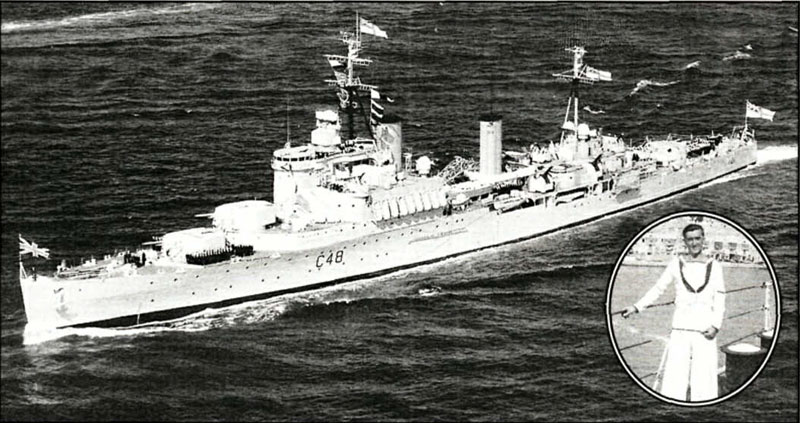
First Ashore: HMS Gambia brought humanitarian aid to the Green island of Zakynthos, devastated by an earthquake in 1953. Inset: Les Newman was there - and back again 50 years on Quake relief
Quake relief that was hit by grenades
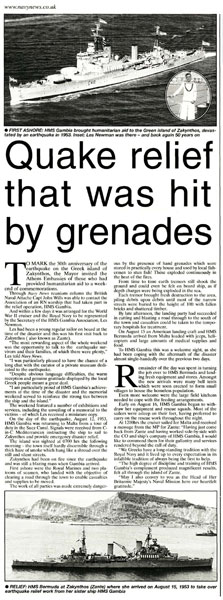 To mark the 50th anniversary of the earthquake on the Greek island of Zakynthos, the Mayor invited the Athens Embassies of those who had
provided humanitarian aid to a weekend of commemorations.
To mark the 50th anniversary of the earthquake on the Greek island of Zakynthos, the Mayor invited the Athens Embassies of those who had
provided humanitarian aid to a weekend of commemorations.
Through Navy News reunions column the British Naval Attache Capt John Wills was able to contact the Association of an RN warship that had taken part in the relief operation, HMS Gambia.
And within a few days it was arranged for the World War II cruiser and the Royal Navy to be represented by the Secretary of the HMS Gambia Association, Les Newman.
Les had been a young regular sailor on board at the time of the disaster and this was his first visit back to Zakynthos ( also known as Zante).
"The most rewarding aspect of the whole weekend was the opportunity to talk to the earthquake survivors and their families, of which there were plenty," Les told Navy News.
"I was particularly pleased to have the chance of a long chat with the curator of a private museum dedicated to the earthquake.
"Despite obvious language difficulties, the warm reception and genuine gratitude displayed by the local Greek people meant a great deal.
"I am particularly proud of HMS Gambia's achievements at the time of the disaster and the memorial weekend served to reinforce the strong ties between the ship and the island."
The weekend featured a number of exhibitions and services, including the unveiling of a memorial to the victims - of which Les received a miniature copy.
On the day of the earthquake, August 12, 1953, HMS Gambia was returning to Malta from a tour of duty in the Suez Canal. Signals were received from CinC Mediterranean instructing the ship to sail to Zakynthos and provide emergency disaster relief.
The island was sighted at 0700 hrs the following morning - the town itself hardly discernible through a thick haze of smoke which hung like a shroud over the still and silent streets.
Zakynthos had been on fire since the earthquake and was still a blazing mass when Gambia arrived.
First ashore were the Royal Marines and two platoons of seamen, who landed with the objective of clearing a road through the town to enable casualties and supplies to be moved.
The work of all parties was made extremely dangerous by the presence of hand grenades which were stored in practically every house and used by local fishermen to stun fish! These exploded continuously in the heat of the fires.
From time to time earth tremors still shook the ground and could even be felt on board ship, as if depth charges were being exploded in the sea.
Each tremor brought fresh destruction to the area, piling debris upon debris until most of the narrow streets were buried to the height of 10ft with fallen bricks and shattered timber.
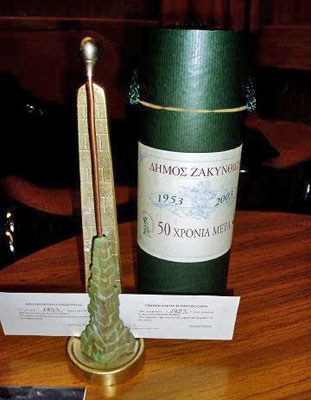 By late afternoon, the landing party had succeeded in cutting and blasting a road through to the south of the town and casualties could be taken to the temporary hospitals for treatment.
By late afternoon, the landing party had succeeded in cutting and blasting a road through to the south of the town and casualties could be taken to the temporary hospitals for treatment.
On August 15 an American landing craft and HMS Bermuda arrived from Malta loaded with jeeps, helicopters and large amounts of medical supplies and food.
To HMS Gambia this was a welcome sight, as she had been coping with the aftermath of the disaster almost single-handedly over the previous two days.
Remainder of the day was spent in turning the job over to HMS Bermuda and landing fresh equipment and stores. Amongst the new arrivals were many bell tents which were soon erected to form small villages to house the homeless population.
Even more welcome were the large field kitchens needed to cope with the feeding arrangements.
Early on August 16, HMS Gambia began to withdraw her equipment and rescue squads. Most of the sailors were asleep on their feet, having preferred to carry on the rescue work throughout the night.
At 1200hrs the cruiser sailed for Malta and received a message from the MP for Zante: "Having just come back from Zante and having worked side-by-side with the CO and ship's company of HMS Gambia, I would like to commend them for their gallantry and services rendered beyond the call of duty.
"We Greeks have a long-standing tradition with the Royal Navy and it lived up to every expectation in its infallible tradition of always being the first to help.
"The high degree of discipline and training of HMS Gambia's complement produced magnificent results, felt all through the island of Zante.
"May I also convey to you as the Head of Her Britannic Majesty's Naval Mission here our heartfelt gratitude."
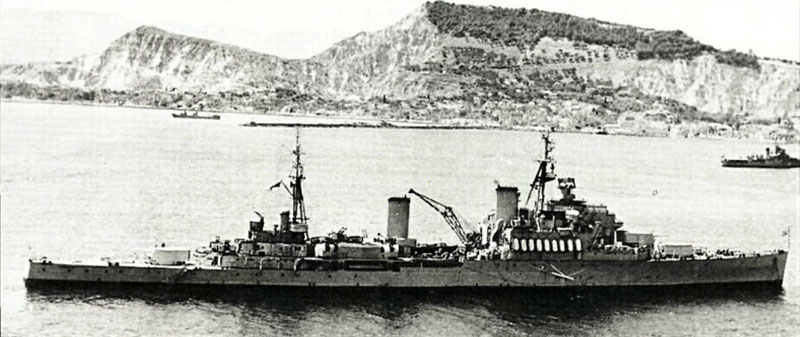
Relief: HMS Bermuda at Zakynthos (Zante) where she arrived on August 15, 1953 to take over earthquake relief work from her sister ship HMS Gambia
The people of Zante are very grateful to the Royal Navy for the assistance given to them immediately after the earthquake. Frank Crompton was on HMS Bermuda and in October 2017, now aged 81, described going back for the earthquake's 60th memorial.
I served on HMS Bermuda and 3 years ago I was traced by the Greek government of Zante I was invited as guest of honour for the 60th anniversary of the great earthquake in 1953 and for the help I did they gave me the highest award they could and I made a speech at the award ceremony. I don't think they could find anyone else as I was one of the youngest on HMS Bermuda as we where the first to the rescue at the earthquake, I was treated like a film star for the two weeks I was there, I was interviewed for TV and the radio plus in all the papers on Zante, I remember how bad it was over 800 people died and only 3 houses where left standing it was a great honor to be given this award and I said it was for all on HMS Bermuda.
I have to point out that Frank is mistaken, HMS Gambia was the first ship there to offer relief. Ray
Frank also emailed me to say that while at the 60th anniversary of the earthquake in Zante he was made a Honorable Zakynthian Citizen and presented with a brass plaque and a carved stone medallion.

Admiral of the Fleet Sir Rhoderick Robert McGrigor, GCB, KBE, DSD, First Sea Lord and Chief of Naval Staff visited HMS GAMBIA in 1953 in Malta. Received on board by Capt P. W. Gretton, DSO, DSC Commanding Officer. Midshipman Raj Bir Mohindra is second in the row.
Evacuation of 40th Brigade, Royal Marine Commando from the Canal Zone
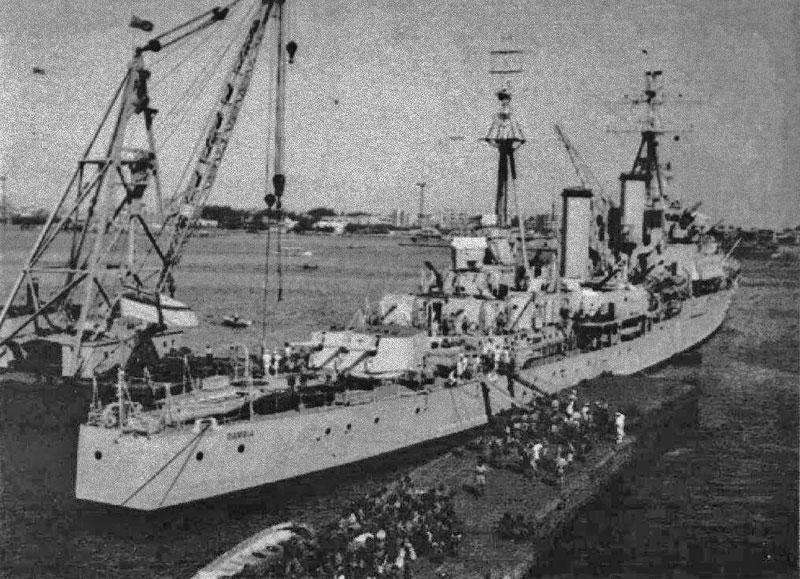
Evacuation of 40 Commando from Port Fouad
Image from Keith Butler
From the 1952 - 1954 Commission Book:
Friday, August 13, 1954, an ominous date, found us on our way to Port Said to evacuate The 40th Brigade of the R.M. Commando from the Canal Zone. We arrived on August 16 in company with H.M.S. Glasgow and secured in the Canal whilst she went alongside Navy House and embarked her passengers. On Tuesday, we took her place and before long the upper deck resembled a cross-channel car ferry as a long succession of lorries, jeeps, water trucks, and utilicons were hoisted inboard and secured in unbelievable places. At 1600 we embarked the brigade and at 1700 we sailed once more for Malta. We arrived safely in Malta on August 20 and disembarked our strange cargo, before securing to our billet once more.
Keith Butler also supplied these images:
Jack Leonard French served as Leading Telegraphist on HMS Gambia on her 1952/54 Commission. On August 8, 2000, Jack recorded an oral history for the Imperial War Museums (IWM 20478). In part 4 of the interview, Jack describes some of the incidents on HMS Gambia such as Greek Xante Earthquake in 1954, the Suez Crisis and the evacuation of the Commandos from the Canal Zone. I have extracted this part of the interview...
A Royal Visit
There is some confusion of when this took place. Several articles say it was some time in 1953 but the 1952/54 Commission Book says it was in April 1954 near the end of long Commonwealth Tour taken by the royal family between November 1953 and May 1954.
Here's an extract from the 1952/54 Commission Book
The following week-end was Easter; for four glorious days no work was done and both watches had two days leave. but with the forthcoming royal visit in everyone's minds (especially the management's) this lost time had to he made up. On April 21, Her Majesty's birthday, a Royal salute was fired, heralding the arrival of the Britannia on the next day. The Royal Yacht was a magnificent sight. Her gleaming hull reflected the ripples of the water, its navy blue striking contrast to the white upperworks and the streamlined yellow funnel.
The arrival of the Royal Yacht signalled a week of feverish activity as the ship was painted from stem to stern, the Queen's Guard, street lining, and crowd control parties were drilled and "illuminate ship" circuits were rigged and tested.
On Tuesday, Their Royal Highnesses Prince Charles and Princess Anne paid the old lady a visit. The chippies had made them a "cruiser" each, and they had great fun navigating their new toys around the quarterdeck. The next day Britannia sailed for Tobruk.
Her week of titivation over. Saturday, May 1 saw the old lady in the role of lady-in-waiting setting out with the fleet to meet Her Majesty the Queen, and eleven o'clock on Sunday morning each sharp crack of her four-inch matched a dozen puffs of smoke and preceded the crackle of a dozen guns as a twenty-one gun Royal Salute echoed between the two lines of warships passing on either side of the Britannia. First one line and then the other wheeled in succession to overhaul the Royal Yacht at high speed, each ship cheering Her Majesty as it passed. As the old lady approached in her Turn the alert was sounded : the crucial moment, the culmination of all the practices and exercises : the well known voice of command boomed over the warning telephone — "Stand by to — " : and some-body pulled the plug out! As the divisions passed the bridge of Britannia the officers in charge, in the absence of orders from the management, took matters into their own hands, and the old lady created a precedent by cheering in succession. The ship passed so closely to the Royal Family that their features were quite easily distinguishable; judging by their smiles they appeared to enjoy the novelty.
The two lines of ships, having cleared Britannia, drew up in column on either side of it before continuing their high speed manoeuvres. A submarine display followed a fly-past as the Fleet performed every item in its repertoire during Command Performance.
At 0900 on Monday the Royal Yacht headed a long procession of ships filing into Grand Harbour. The old lady excelled herself by taking only twelve minutes from the time she passed the breakwater until she was tied up.
Massed bands played amidst huge banner-waving crowds from every vantage point around the harbour. Almost as soon as Britannia had secured the Royal Barge slipped away from her side and sped for shore. Large crowds clapped the Royal car as it drove up Crucifix Hill to Floriana where the Queen unveiled a memorial to airmen killed in the Mediterranean during the war. Three thousand relatives of these men had been flown or shipped to the island to watch the ceremony. This was the first of Her Majesty's many official engagements, which included the Services' Parade to which the old lady contributed.
The Royal visit was like a great fiesta; streets were gay with coloured lights and decorations and every night petards ponged and rockets soared : the ships in the harbour were dressed in bunting by day and bathed in floodlights at night, and from all over the islands, crowds flocked to Valetta.
At 1630 on Friday, May 7, to the sound of a farewell salute, Britannia steamed past the crowded barakkas and through the breakwater for Gibraltar and home.
An explanation is necessary to make this timeline clearer. Easter Sunday in 1954 was on April 18 and April 21, 1954 was a Wednesday. HMY Britannia was brand new and left Portsmouth with Prince Charles who was 5, and Princess Anne who was 3, on Wednesday, April 14, 1954 on its maiden voyage. It arrived at Malta on Thursday, April 22. Queen Elizabeth and Prince Philip were on their Commonwealth Tour and after leaving Malta, HMY Britannia picked them up at Tobruk on Saturday, May 1, 1954 to bring them to Malta. This is how the children were on HMS Gambia on Tuesday, April 27 and how HMS Gambia saw HMY Britannia twice, once with just the children and later with the entire royal family.
The Royal Familiy Visit Malta, 1954
The children were left alone by the press, but two crew members, Bernard Weeks and Raj Bir Mohindra took these photos of Princess Anne in her own little cruiser. Bernard Weeks was a Leading Seaman while Raj Mohindra was an Indian sailor on HMS Gambia as a midshipman.
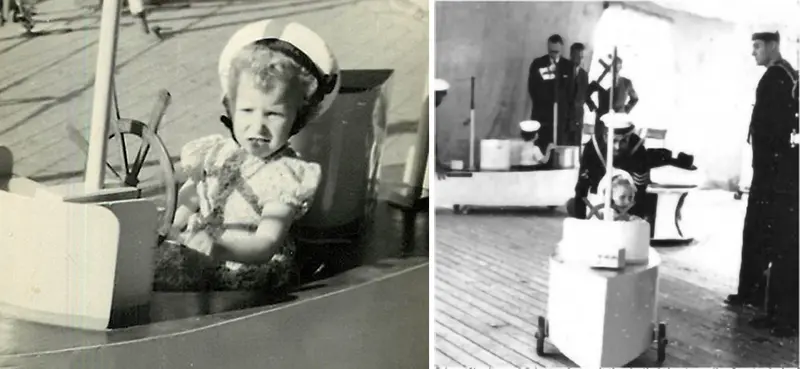
Princess Anne in her own little cruiser on HMS Gambia, April 27, 1954
From the Daily Mail, August 24, 2012
She may have been just three and at the helm of a toy boat, but the same wistful gaze to the horizon is plain to see. As this picture taken in 1953 [sic] shows, Princess Anne's love of sailing began at a young age. The photo of the young princess was taken in Malta aboard HMS Gambia when the Queen and Prince Philip paid a visit with Anne and Prince Charles.
Bernard Weeks, 78 in 2012, then a leading seaman in the ship, kept a copy as a souvenir. He said: "We built two wooden boats and the children had a great time pedalling up and down on deck. We also dressed up as pirates and threw a birthday party for Charles."
Raj Bir Mohindra met Prince Charles again in 1992. This is an extract from The Statesman of September 15, 2022
I then pulled out a photograph from my pocket and told him, in good humour that in that case I would reproduce it in picture in lieu of his message. Prince Charles looked at the photograph intently and asked, "Where the hell did you get this from?” I said that in 1953 [sic], I was a Midshipman on board HMS Gambia, the Flagship of Vice Admiral Lord Mountbatten, Commander-in-Chief of the Mediterranean Fleet, based in Malta.
The Queen, the Duke of Edinburgh and their children had been invited by Lord Mountbatten to visit Malta on a holiday. Her Majesty's Yacht HMS Britannia was tied to a buoy in the Valletta harbour, just aft of Gambia. "One of the items on the programme was 'Prince Charles and Princess Anne play with the Midshipmen on board the Gambia'. The boats in which you and Princess Anne are joyfully sitting were built on board by the Midshipmen. I took this photograph with my box camera." Prince Charles had a hearty laugh and said: "Oh, we have a blackmailer here!"
Midshipmen's Collection
In September 2025, I received an email from Raj Bir Mohindra who was a midhsipman on Gambia's 1952 to 1954 Commission. The email contained a photo and an interesting story. Raj wrote:
I came across a photograph from my Gambia days. During our time as Midshipmen, one of the "illegal" activities we indulged in was collecting interesting signboards and adding them to the Gunroom collection. I still remember how the more enterprising Midshipmen kept a screwdriver hidden in the sleeve of their jacket! The Gambia Midshipmen were the undisputed champions of this mischief in the Mediterranean Fleet.
I wonder whether this tradition is still carried on by today's Midshipmen of the Royal Navy - or whether it has long since been banned by Their Lordships.

Midshipmen's signboard collection
Royal Hotel, Suiza and Trocadero Bars, Gibraltar
These images were on the original HMS Gambia Association website and were submitted by various people. I think I have now managed to attribute them properly. It seems there were two photo-journalists on Gibraltar during 1953/54, they were Ralph Crane of Life Magazine and Bert Hardy of Picture Post.
There's copies of these and other great pictures of Gibraltar in the 1950s on the Gibraltar Blogpsot pages, here, here and here.
Hank Herbowy and I have kept in touch and in 2018, he emailed me a copy of his wedding photo and I thought it would be a nice way to end this page. He and Gloria were married on February 1, 1958.

Gloria and Hank Herbowy on their wedding day, February 1, 1958


